Buses, buses, and buses—public transit from the DMZ to Haeundae Beach.
My friend Dan Leonard and I met recently at an eel restaurant in Soyosan, South Korea, a small town just south of the DMZ, home to little more than mountains and soldiers. We were about to embark on an audacious quest: there’s an urban legend that you can go from one end of South Korea to the other on local transit, and we wanted to find out how. This would mean no intercity buses, trains, or ferries—just the regular mass transit that requires nothing more than a transit card or some loose change. The type of transit legions of weary commuters rely on each day in cities all over the world.
Dan is a comical, heavy-set Buffalonian of 41 years who chooses his Hawaiian shirts strictly for the purpose of upsetting me. He has lived in Korea since 2001 and speaks fluent Korean, which is necessary for our trip since I speak limited Korean, and very badly, despite having lived in the country for 14 years.
When we told the eel restaurant manager about our plan, he looked at us like we were idiots—a look that would become all too regular throughout our journey. He then suggested a faster way: take the subway to Seoul, get off at Seoul Station, and get the KTX bullet train to Busan. We would be there in three hours.
But what’s the point of that? Anyone can zip through the mountains, safely in the womb of a bullet train, only to be birthed at the other end. We wanted an adventure. We tried to explain this, but the manager shook his head. The idea that one would waste three days of his or her life for the sake of a story to tell friends over beers back home made very little sense to this man, a thought shared by many of the Koreans we encountered. But it made great sense to us. We were going to see Korea from the ground.
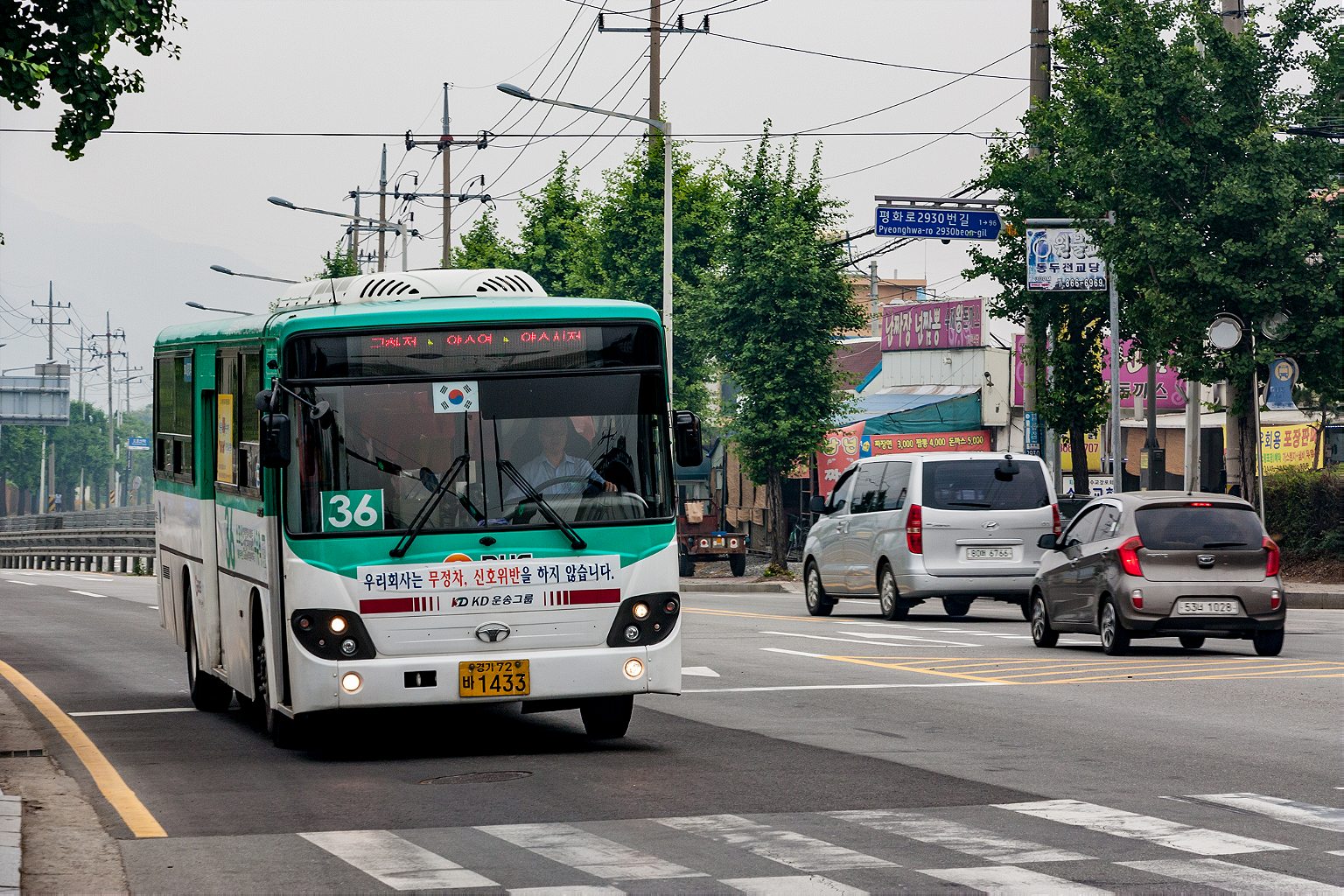
The first leg began the morning after the eel, with Bus 36 from Soyosan to Suyu Station on the north side of Seoul. Line 1 of the Seoul Metro could have actually taken us all the way from Soyosan right down to Asan, well south of Seoul, but that kind of felt like cheating. So we decided to eliminate subways—too easy—and focus on buses.
The obvious problem with buses over subways is traffic. Luckily, Seoul and surrounding Gyeonggi province have bus lanes all around the city, and we cruised past jammed morning traffic—an auspicious beginning.
Unluckily, despite a widespread ad campaign on every bus and subway in the country, public transit etiquette is still below that of much of the modern world. It’s common to see people sit on outside seats without moving in to allow other people to sit. Young people almost never get up for older people. This is particularly irksome to foreigners in Korea, since we are told repeatedly that in Korean culture, “you stand for your elders, unlike in America.”
At the end of our first leg, we were in full-on Seoul, complete with McDonald’s and cellphone shops numbering three to a block. Dan and I boarded Bus 142 to Sunyuhyang Hospital, then the 5005 Express across the Han River, and raced back out of Seoul to Yongin Bus Terminal. We traversed the fourth biggest city in the world in about two hours.
Yongin was a quiet place. We watched a crane wash itself in the small river running through. We found a little Chinese delivery spot that had a couple tables out for customers. We charged our phones and planned the rest of the journey over black-bean noodles for me and shrimp-fried rice for gluten-intolerant Dan.
The area around Yongin Bus Terminal, in the old city, is where the poor people end up. All over the country, it’s at the bus and train terminals you find the most of those left behind by South Korea’s Miracle on the Han, gathering together to drink soju (the most popular booze in Korea) and eat instant noodles.

Bus 22-1 to Anseong pulled out of the station and into the farmland. Dan began a discussion in the back (where I won’t ride because of motion sickness) with a college girl who was thrilled to be able to practice her English with a native speaker. Dan’s good like this—because of his Korean abilities, Koreans feel close to him and are often willing to talk, despite the repulsive loudness of his shirts.
We made our way into the country. The rice crop in the summer is a bright, beautiful emerald green, and grows in thin rows. Black canopies cover other crops—mushrooms, maybe? Ginseng?
There is a persistent fear in Korea that the countryside is dying, and with good reason. The population is aging and there are very few children. Every time the bus stopped, it would let on a small, elderly man or woman with a cane, often hunchbacked, a testament to the hard work and bad nutrition of decades of grinding poverty.
They elderly in Korea often still work, and for pennies—poverty among the old in Korea is nearly 50 percent. While many of their children and grandchildren have moved to the cities and adopted the Gangnam Style life, the old are often relegated to making $2 or $3 a day collecting cardboard, cleaning up the road, or working on the farm. Many cannot afford cars or drive, and these buses, which are discounted for senior citizens, are their only connection to friends and family in nearby communities.
In Anseong, Dan got us lost. It’s not strictly Dan’s fault of course, but since he is the only Korean speaker among us, I blame him. We got off at the central roundabout in Anseong, a small town with a big pagoda by a river, and began searching for Bus 201 to Cheonnan Terminal.
The problem was a total lack of the visual aids that help you get on the right bus—signs with bus numbers; posted schedules and routes; digital panels that tell you when the next bus is coming. Instead, there was just a gray post with a sign that read, “BUS STOP” in English and Korean. Whether the bus there takes you to Yongin, Cheonnan, or the dead-end of Manchuria is unknown.
We were pointed in three different directions by a series of cab drivers, coffee baristas, and old men in the street, but we found the 201 only when we saw it go by and ran for it—missing it. We waited for the next one alone for 20 minutes. Once we got on we were alone, and I felt this was the right time to surprise Dan with the flask of Canadian Club I had prepared before leaving. We drank happily until the next stop when about 25 screaming school children got on and we felt obliged to put it away.

From there it was a series of straight shots to Daejeon and then Sejong City. It was nightfall by the time we arrived in Sejong, but as soon as we arrived we knew weren’t going to be spending the night there. Sejong is a new city, and was as far as we could tell, bereft of hotels. It was built by the government as an administrative capital, a way to create jobs and an economic center outside of Seoul. What they ended up doing was creating a capital city that only rivals Canberra in terms of joylessness, ugliness, and lack of spirit. Bus 990 got us out of there and to Daejeon’s Banseok Subway Station.
There’s an old joke in Korea: What do you call a foreigner who speaks perfect Korean? Elder. The Mormon missionaries here are always easy to pick out from the other foreigners, because they are young, well groomed, extremely polite, well dressed, and are desperate to talk to someone in English about anything but Jesus. Bring up their hometown football team, and you’ll have a friend for life.
At Banseok, two Mormon missionaries from L.A. helped us navigate to a hotel district. When we found it, there were all the traditional Korean hospitality options: hotels; “motels,” which just means cheap hotels; “yeogwans,” more insalubrious cheap hotels; “minbak,” traditional places where you sleep on the floor; “Love Motels,” where you meet your boyfriend or girlfriend for a romp away from the prying eyes of parents or spouses; and “Muintel” which are Love Motels for the very shy—you get your key from a machine and head to your room, without ever having to shame-facedly make eye contact with a concierge.
We ended up at a mixed yeogwan/Love Motel, went to a Mexican restaurant, and celebrated the end of our first day. I got a beer and Dan got a whole liter glass of mojitos.
On Bus 607 to Okjeon, it became more rural again. The accents also started getting thicker. No longer were people speaking “standard” Korean, but rather their own provincial dialects, which meant it was getting very hard for Dan to both understand and be understood. We were also becoming quite a novelty—what were these two fat, middle-aged white dudes doing in Okjeon, which hasn’t many foreign faces since the U.S. Army stormed through it in 1951?
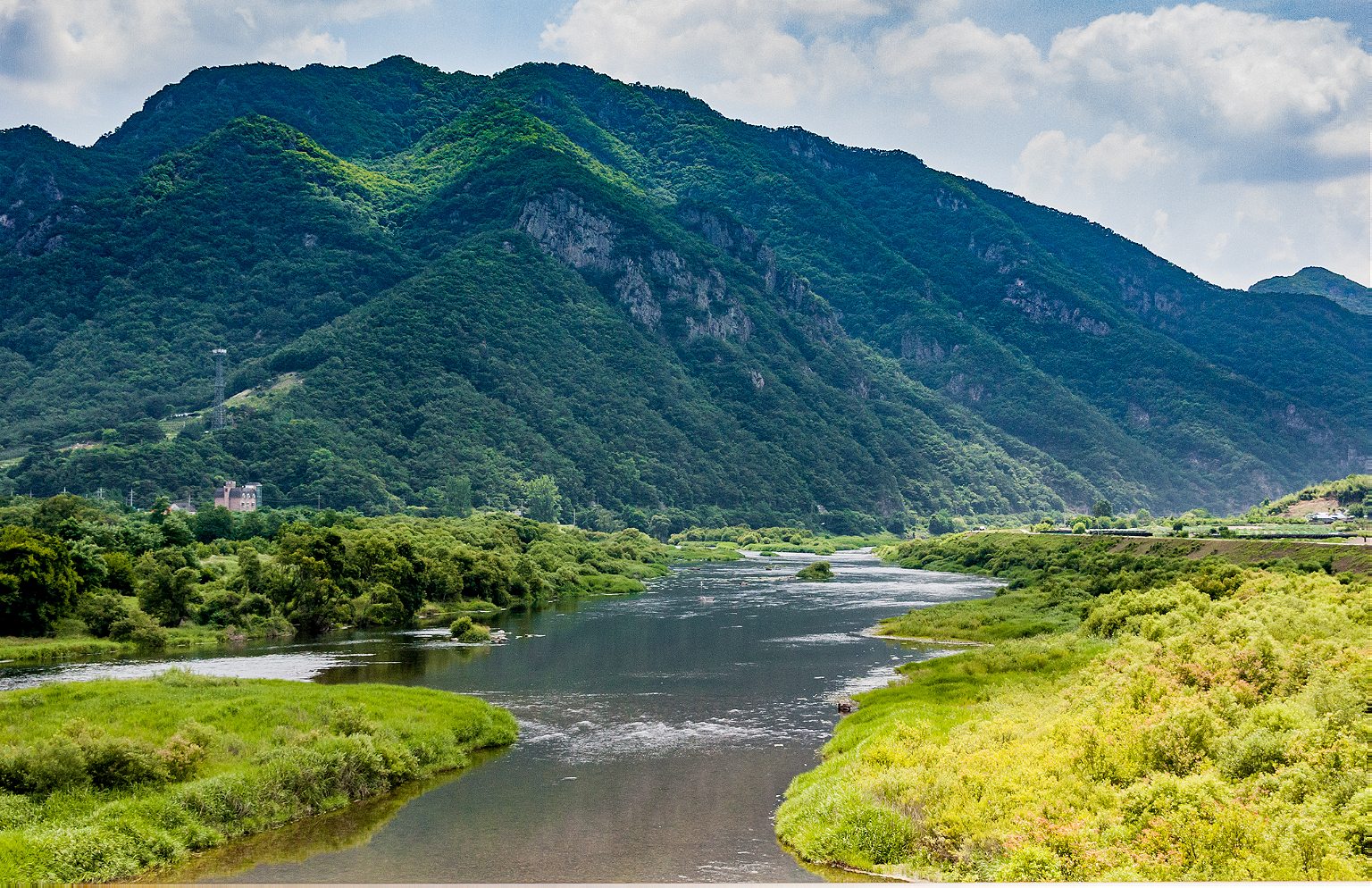
It was around Yangsan that our luck ran out. We needed to get to Kicheon eventually, and once we clarified—again—that we couldn’t take the Intercity, the driver and all the passengers got in a furious discussion about how that was going to happen. People yelled over each other, suggested gas stations and bus stops, loudly debated over when the next bus came, whether the bus came at all, and would it take us anywhere civilized. Finally, the driver overruled them all, dropped us on the side of the road in tiny Nochon-li, and told us to go to the gas station and get a bus to Kicheon.
At the gas station they assured us there was indeed a bus to Kicheon—it would be leaving in four and a half hours, at 8 p.m. After checking out the liquor stock at the corner store, we decided it was impossible to stay in this town for more than 20 minutes. We learned that we could walk to Hwangan, a slightly larger town four miles up the road. So we bought some roadies and started up the road.
It was hot and there was nothing around us but rice paddies and little concrete houses. After about two-and-a-half miles, a bus pulled up next to us. It was the 125 that we had taken in, making the return route. The driver opened his door and ushered us inside. “What happened?” he asked. When Dan explained, he and the other passengers roared with laughter. They drove us to Hwangsan Bus Terminal for free.
Two buses later and we were in Gumi, at another cheap motel amid another gaggle of cheap motels. We ate a feast of barbecued pork, and Dan, who had long ago given up soju, decided to share a bottle of Korea’s national spirit with me. We knew that tomorrow was going to be the most difficult leg of them all—south through rural Gyeongsang Province to Busan, and our final destination, Haeundae Beach.
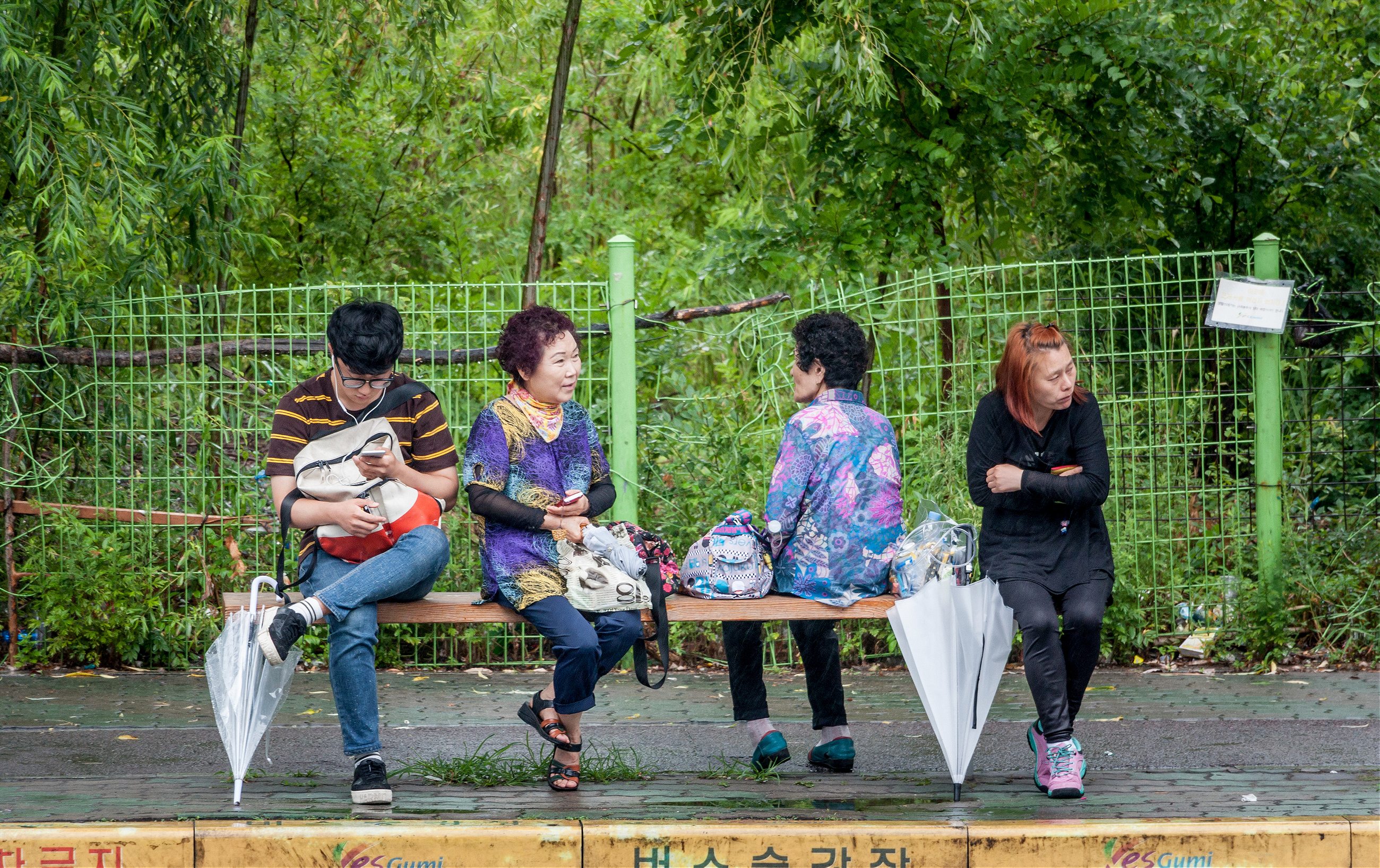
We had decided to get up bright and early, but when I knocked on Dan’s door at 8:30 a.m., he was still asleep. He agreed to forfeit his vital morning coffee, beans he had brought all the way from Vietnam to Korea, so that we could get on the road by 9:15.
It was pouring rain outside and a bit chilly on Bus 172 to Wegwan. Once we arrived, we had a half hour wait so we retired to a café and ordered coffee and bagels. None of it came until a younger woman rushed in like a paramedic, prepped it all in two minutes, and sent us on our way to Daegu.
Bus 250 to Daegu North was the oddest bus we’d been on, decorated like your grandmother’s living room, all in purple, with doilies over the backs of the seats and ribbons on the windows.
Daegu is home of Korea’s biggest market for traditional Oriental medicines. The streets are lined with shops full of canned and bottled ginseng, branches wrapped in twine, pastes, and salves, acupuncture needles, and the like. We stopped in at a restaurant for two bowls of samgyetang—boiled whole young chicken with ginseng and other medicinal herbs—that came with a small bottle of complementary ginseng liquor.
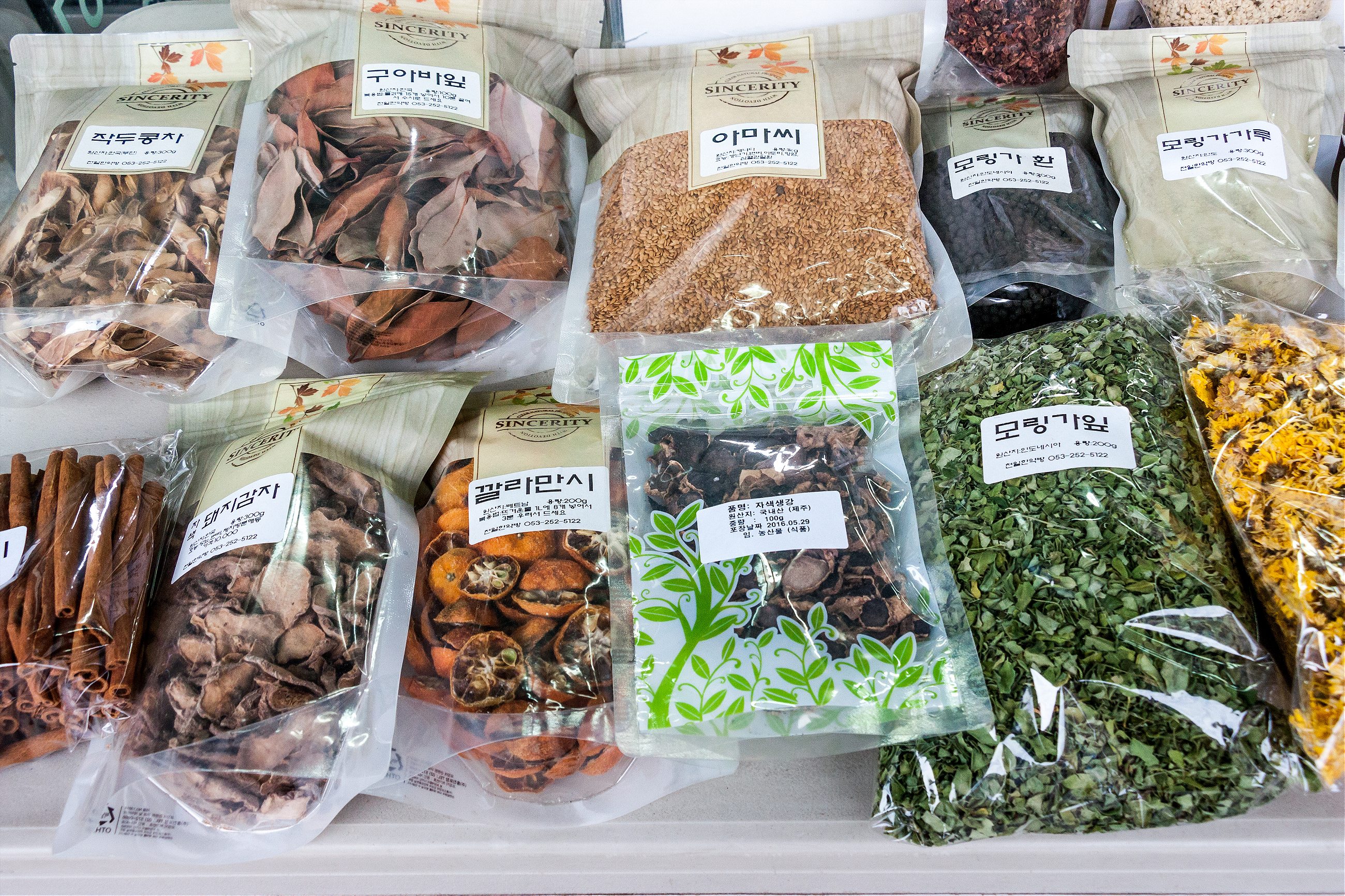
Dan spent most of the meal tapping on his phone—things were not looking good. It appeared as though we were stuck. There would be no local bus to Yeongcheon, the next town over, until the next morning, even though it was barely noon. Once we reached Yeongcheon, there would be no buses until the morning after that. This wouldn’t do: we didn’t have the money, or, frankly, the patience, to spend Friday and Saturday night in Daegu and then Yeongcheon.
We had to face the fact we were going to fail. We’d need to take the Intercity bus from Daegu to Gyeongju. Still, it was a noble failure. Beethoven had sought to create the greatest work of music ever with the Ninth Symphony; Proust had sought to redefine literature with Swann’s Way. Neither had succeeded, but they’d produced masterpieces nonetheless. We were producing a masterpiece of intercity travel, but we would have to cheat. So with heavy hearts we got Bus 5 to the Daegu Intercity Bus Terminal, and boarded the Intercity to Gyeongju.
I won’t pretend I didn’t enjoy it. Any guilt was mitigated by the reclining seats and lack of stops. It was a fast and beautiful zip down the rainy highway to Gyeongju. After we were spat out at Gyeongju Terminal, it was all simple again. We only had to cross the road and get the 500 Express to Bonggye Market.
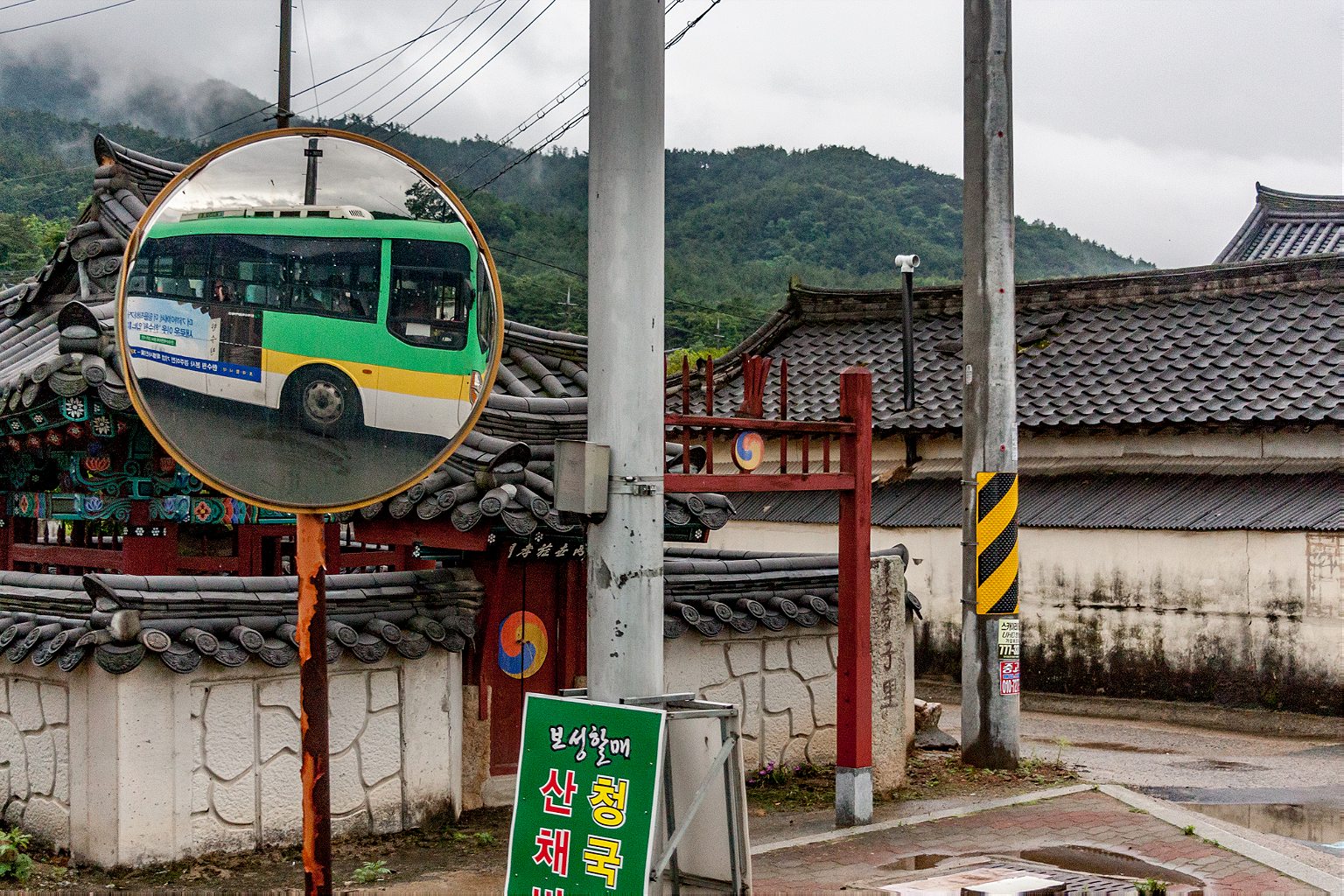
Gyeongju was the capital of Korea’s 1,000-year long Silla Dynasty, which lasted until the 14th century, when the new Joseon kings moved the capital to Seoul. It’s dotted with temples, palaces, and great burial mounds, which look like simple grass covered hills, but are where hundreds of Korea’s kings and queens are interred. It’s Korea’s second most visited destination after Seoul, but we saw it only through the bus windows.
We boarded the 308 to Ulsan KTX Station. At Ulsan I bought a small flask of soju from the 7-11 to get us through to Haeundae.
The 3000 Express to Yangsan left from in front of the station, and from Yangsan, we caught the 11 to the city. Dan used to live in Busan, and so from here it was simple. We got off at Sponge (pronounced Spongee) Mall, and caught the 100 to Haeundae, the most popular beach in Korea.
We were dropped about three blocks from the beach, and we could smell it. The clouds had dispersed and it was a clear night. We walked to the beach at a reasonable pace; we didn’t want to rush this moment, but at the same time, we were eager to get there, for it to be over.
We had done it—well, almost. We had done it the best we could, a single intercity bus notwithstanding. Twenty-four buses, 595 stops, across five provinces and five independent cities, about 280 miles and 30,000 won—$26—on our transit cards, another 7,000 won paid in cash.
We embraced a few feet from the sea, and dragged our battered bodies to the shoreline, where we celebrated our success at a line of bars, where Dan drank no soju whatsoever.
